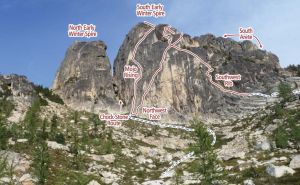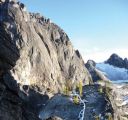Mojo Rising, South Early Winters Spire III 5.11b C1+ |
||
Washington Pass, Washington, USA | ||
| ||
|
Avg time to climb route: 3-6 hours
Approach time: 1.5-3 hours Descent time: 1.5-3 hours Number of pitches: 5 Height of route: 800' Overview
Mojo rising on South Early Winters Spire is a newer climb on solid and featured rock. It consists of a steep, bolt-protected face climbing pitch, some short but fun aid, followed by more moderate, traditionally protected climbing. Despite being a relatively new route, Mojo Rising is reasonably clean. On the lower pitches, this is a result of effort on the part of the first ascent team. With more traffic, the upper pitches will hopefully get brushed and cleaned of lichen. As this happens, Mojo Rising is likely to become known as a classic. Mojo Rising is a good route just for the quality of movement or to prepare for longer, mostly free, big wall style routes such as Liberty Crack, the Salathé or the Nose.
Photos
- View all 2 photos of Mojo Rising as: Thumbnails | Slideshow
Climber Beta on Mojo Rising
Find other routes like
Mojo Rising
Route History
First climbed in October 2006 by Mark Allen, Tom Smith, and Joel Kauffman. The idea for the climb occurred earlier that summer during a climb of the northwest corner of NEWS, when Mark Allen and Paul Butler got a closer look at this crackless Pitch 1. They were intrigued by the fun, sporty face as their eyes moved from feature to jug to seam and finally to crack. “Wow, that looks sweet!” Allen exclaimed then and the next three times he stood under the face that summer. He knew it needed bolts. After some internal debate and discussion with local first ascentionists, Allen decided it could be worth it. Finally, during the second week of October, Allen rap-reconned the face to confirm the line’s continuity before a single hole was drilled.At this point, Allen thought the route looked worthy. The belay stances and the features rocked, but the gear did not. Allen, Smith and Kauffman established bolted anchors at three belays lower on the route. The trio spent some time cleaning and gardening the cracks that needed it the most – Pitch 3 and down, the steepest part of the route. Pitch 1 required seven pre- placed bolts over 90 feet and a short A0 bolt ladder to the belay. After the work cleaning, bolting and reconning the route, they pulled the lines and took a rest day. The group started off at 8:45 on Oct. 13. Allen recalls, “Alpine starts were not an option during the fall cold temps and the face does not get sun until afternoon.” Kauffman was the first to redpoint Pitch 1 in the cool morning temps. The trio raved about this classic pitch. After Allen aided Pitch 2, Smith launched onto Pitch 3. Unable to trust his feet to place gear from, he resorted to three direct aid placements to gain the stellar dihedral. With darkness approaching, they fixed their lines and rappelled to the ground. The following day, the three climbers returned and ascended their ropes. Kauffman lowered 15 feet from the anchor and pendulummed over to the ramp. They called this exposed 5.7 ramp, the “Sidewalk in the Sky,” then shortened it to the “Skywalker Pitch.” Next Allen recalls, “Originally, I had planned to work the line up the laser corner crack formed by the dihedral. This did not directly connect with our summit cracks. On the other hand, just to the left was a much simpler 5.9 crack that did connect. The choice was simple. I got into an insecure layback with dirty flaring ring locks.” One more moderate pitch and they gained the Southwest Rib and simul- climbed to the top. This trio approached the Mojo Rising project with the vision that in the future the route could go entirely free. They made the effort to create a user-friendly line, left cracks that were just protectable bolt free and bolted the faces to preserve an honest free ascent. As of the writing of this book, Mojo Rising still awaits a free ascent. Strategy
Because of the rating and the newness the route, crowds are unlikely. Part of Pitch 1 can be done as a sport pitch, just draws for pro and with one 60m rope you can lower to the ground.Pitch 1 starts on easier 5.7 that is a little runout. Once you reach the first bolt, the business begins with mostly pumpy and sustained 5.10+ climbing involving lots of laybacking and stemming. You can pull through the hardest 5.11 moves on gear, but be prepared to climb mid-5.10 with the bolts a short ways below your feet. This is an excellent place for 5.10+ climbers to push themselves at the 5.11b grade. If you’re planning on climbing the whole route, don’t belay at the first set of anchors. Instead climb through and pull on bolts and two fixed pins that lead you to a small stance and a two-bolt belay. Pitch 2 is pretty straightforward but has a few tricky C1+ placements – a great place for experienced rock climbers to learn to aid climb. After the aid section on Pitch 3, don’t get suckered too far up the corner above you. Instead, look for the traverse to your left and around a blind corner the next belay. The corner on Pitch 5 is an excellent 5.9 finger crack that you’ll wish kept on going. Leave trekking poles and any other extra gear at the base of the route, descend the South Arête, and walk around. Bringing approach shoes is debatable. There is some aid climbing for which some climbers might bring their approach shoes. In addition, the hike back to the base is on a steep, sandy trail and takes about 10-15 minutes, so most opt to bring their approach shoes up and over. Depending on the comfort of your rock shoes, you may or may not. Retreat Storm
Mojo Rising gets a lot of sun and dries relatively quickly after a storm, though Pitches 3 and 4 can remain slightly damp even when the rest of the route is dry. To retreat, you need two 60m ropes, and each of the first three pitches have bolted anchors. After the traverse on Pitch 4, retreat is more difficult but not impossible to reverse.
Everything You Need to Know About
Washington Pass
Search the internet for beta on
Mojo Rising
|
Other Routes on South Early Winters Spire
|






